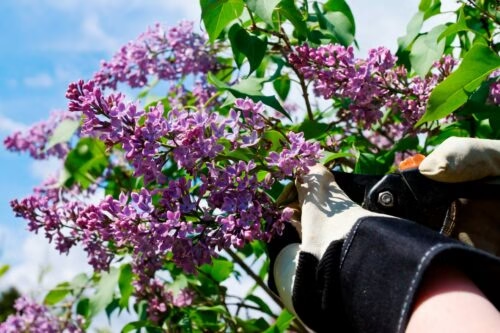Can I prune lilacs in the fall? The Lilac is one of those few plants that every gardener wishes to keep well maintained at all times.
Can I prune lilacs in the fall?
For instance, I usually prune my old, overgrown lilac plant at every beginning of fall to keep it in good shape and ensure it bears enough of its beautiful flowers.
My lilac is one of those few plants that have survived several garden renovations because of its beautiful steel-blue double flowers and also blocking the view of my neighbor’s garage within my home garden.
Can I prune lilacs in the fall?
Lilac flowers are beautiful and fragrant that giving a home a decent environment to reside in.
However, if neglected, lilac plants can overgrow such that it produces a few flowers that are so high up on the plant, making it difficult for you to enjoy them.
This is the main reason why an old lilac shrub needs pruning at the right time.
Note that pruning during the rejuvenating period can reduce the number of your lilac flowers.
As your lilac plant gets older, its flowers tend to become smaller, fewer.
And out of reach away from the stem. Proper pruning is the primary technique of ensuring your lilac plant produces reliable flowers for several decades in your garden.
The age of your lilac shrub determines which pruning technique you will use during your annual maintenance routine as it helps keep the plant vigorous.
Ideally, the older the plant, the more severe pruning you can apply and vice-versa.
Here are a few pruning guidelines.
- Flowering shrubs should be pruned immediately after blooming.
- You can prune the non-blooming shrubs in early spring or late winter.
- Heavy pruning or shearing isn’t recommended past July 31st
- Prune the fruit tree or deciduous tree in early spring.
- Rejuvenation pruning is recommended in early spring after flowering.
However, there are several exceptions.
All diseased or dead wood should be removed at any time.
It is okay to light shape a shrub with uneven growth during the fall.
Remove stems growing out of the parent shrub by cutting them down close to the main branch.
Do not shear the extra stems!
This is because shearing will only promote new and unwanted stems since they can lead to winter damage.
It’s okay to cut the evergreens for decoration purposes and cut the stem adjacent to the parent branch and inside the shrub to shun chances of new stem growing.
After how long should I prune my Lilac?
It is highly recommended to prune your Lilac annually to promote growth.
Develop an excellent stem framework vigorously, and increase the plant’s flowering ability.
Remember, annual pruning involves cutting down any deformed, diseased, or unproductive stems.
Proper spacing is also achieved by removing several stems from the parental branch.
Besides, you can cut off several new shoots arising from the parental roots since this helps prevent them from straying away from the center of your plant.
You can reduce overcrowding by allowing only a few inches between the stems.
To achieve maximum flowering, ensure you retain those shoots with a pencil-like thickness along the branches since they are highly productive.
The small, twiggy nodes aren’t that productive and rarely produce flowers. Besides, twiggy growth is a sign of large shades and several old and non-productive stems.
You can remove the extra stems immediately after flowering since you can quickly identify the unproductive branches.
Moreover, you can still do your pruning during the late winter if you will be okay to sacrifice a few blossoms.
Note that stems and shoots must be cut off below or at the soil level.
As your lilac plant ages, the old branches should be removed to give room for the younger productive stems.
A little pruning after two-three years can keep your lilac plant free from rejuvenation.
Is deadheading necessary during pruning?
Yes, deadheading is also a critical part of your yearly lilac maintenance and should be done immediately after the fading of flowers.
Cut off the old flower clusters and preferably at their base- above two to three shoots arising from the stem that just ended with the existing height.
Those new shoots will mature over the summer and likely set flower buds topped off with several flower clusters next spring.
Cutting off the aged blossoms enables the plant to direct its energy into the growing shoots so that they can produce vigorous flower buds.

